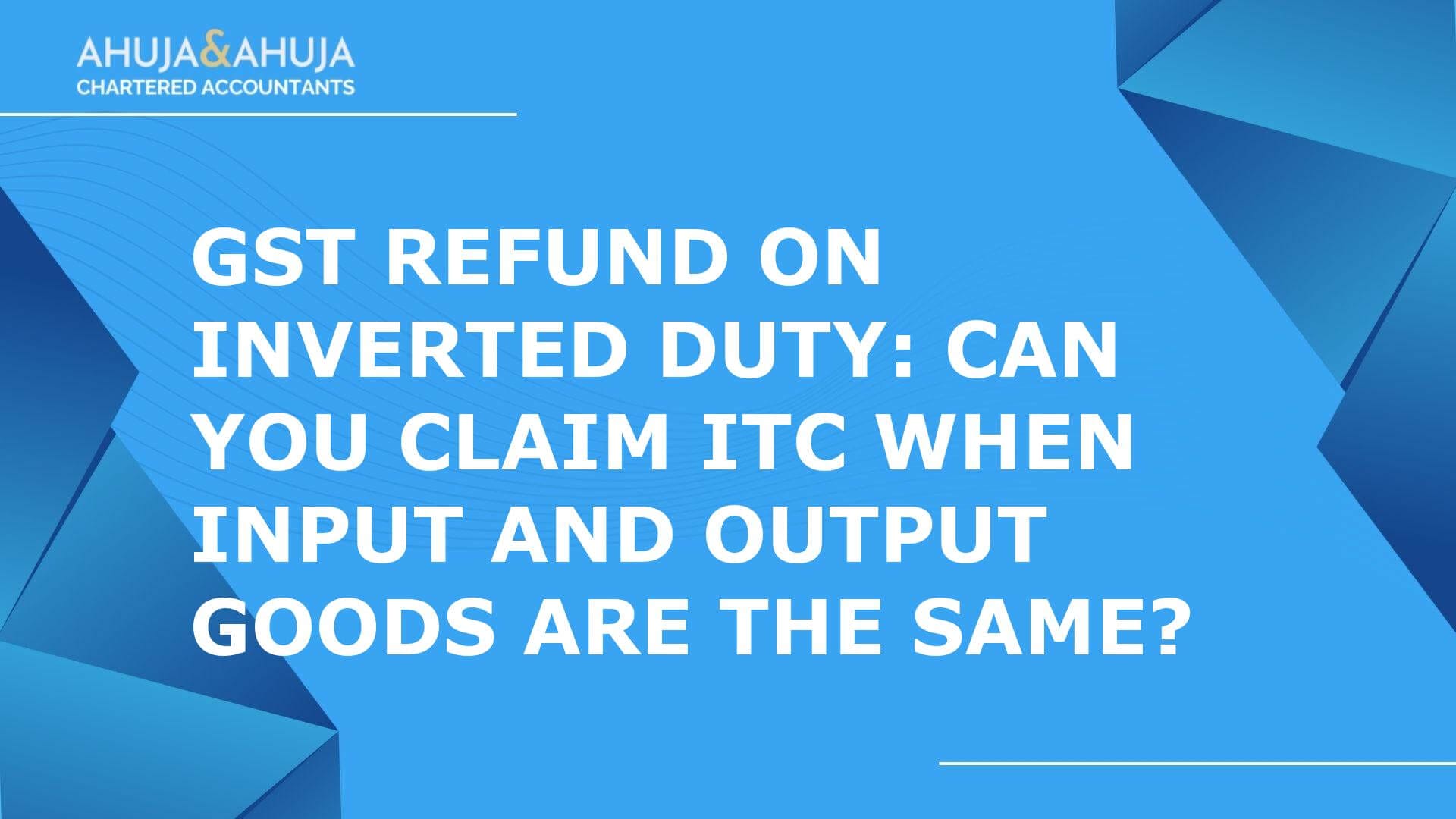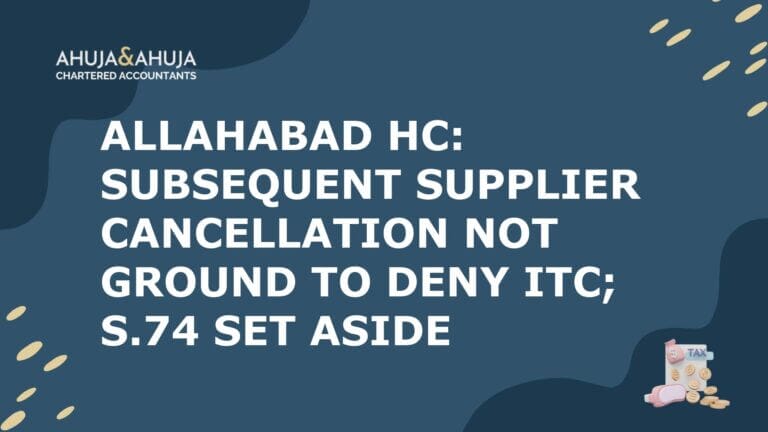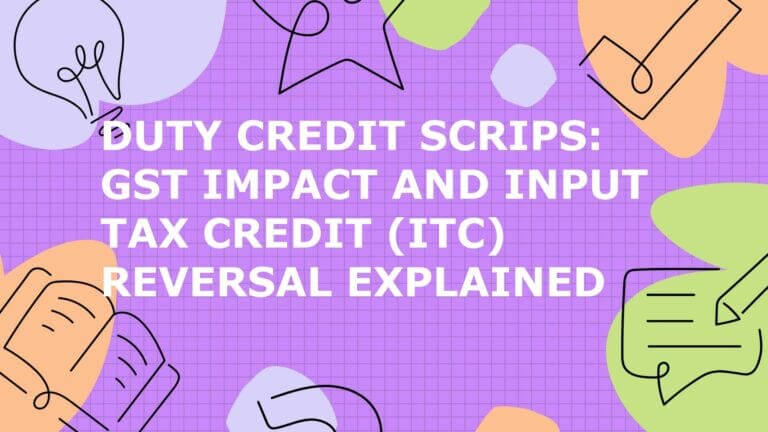GST Refund on Inverted Duty: Can You Claim ITC Refund when Input and Output Goods Are the Same?
India’s GST regime was designed to ensure seamless credit flow and avoid tax cascading. Yet, for many businesses, especially those dealing with similar input and output goods—like T-shirt printers and sellers—navigating the refund maze under the “inverted duty structure” can feel like walking a tightrope. Officers often deny refunds, arguing that if the main input and output are the same, the claim doesn’t fit the law. But is that always correct? Let’s break down the legal, procedural, and practical realities, so you can claim what’s rightfully yours—without falling into compliance traps.
Understanding the Inverted Duty Structure
The inverted duty structure arises when the GST rate on inputs (purchases) is higher than the rate on outputs (sales). This leads to the accumulation of Input Tax Credit (ITC) that cannot be fully utilised against output tax liability. The GST law recognises this hardship and, in principle, allows for a refund of such unutilised ITC—subject to certain conditions.
But what if your main input and output are the same product? For example, you buy plain T-shirts (input), print on them, and sell the finished T-shirts (output). The confusion deepens if your output is taxed at a concessional rate, while your inputs (like ink or thread) attract a higher GST rate. This is where both the law and its interpretation by officers come into sharp focus.
Learn more about GST refund services and how expert assistance can simplify your claim.
Legal Backbone: Provisions Governing Inverted Duty Refunds
Section 54(3) of the CGST Act is the cornerstone for refund of accumulated ITC due to inverted duty. It states:
“Where the credit has accumulated on account of rate of tax on inputs being higher than the rate of tax on output supplies, refund of the accumulated ITC shall be allowed subject to such conditions and restrictions as may be prescribed.”
Key points:
- The law’s intent is to provide relief where higher input tax rates cause credit pile-up.
- The focus is on “inputs” (not input services or capital goods).
Section 2(59) of the CGST Act defines “inputs” as:
“Any goods other than capital goods used or intended to be used by a registered person in the course or furtherance of business.”
Rule 89(5) of the CGST Rules prescribes the formula for calculating the eligible refund:
Maximum Refund = (Turnover of inverted rated supply of goods and services × Net ITC ÷ Adjusted Total Turnover) – Tax payable on such inverted rated supply
Jargon Buster:
- Net ITC = ITC availed on “inputs” during the relevant period (excluding input services and capital goods).
- Inverted rated supply = Output supplies where the GST rate is lower than the input GST rate.
For detailed procedural insights, check our GST refund filing services.
Eligibility for Refund When Inputs and Outputs Are the Same
This is where things get tricky. Officers often argue: “If your input and output are the same (e.g., T-shirt in, T-shirt out), how can there be an inverted duty?” But the law and recent CBIC clarifications tell a more nuanced story.
Why Refunds Become Contentious
- If both input and output are taxed at the same rate, refund is not allowed.
- If output is supplied under a concessional notification (e.g., a lower GST rate for a specific supply), but inputs (like ink, thread) are taxed higher, refund may be allowed—even if the main input and output are the same.
The Role of Concessional GST Rate Notifications
Suppose you buy T-shirts at 12% GST, but due to a government notification, you sell printed T-shirts at 5%. Your ink and thread are taxed at 18%. Here, the output is taxed lower than the input, and the law recognises this as an inverted duty scenario.
User Q1: How can a taxpayer demonstrate eligibility for an inverted duty refund when the main input and output goods are identical, but the output is supplied under a concessional GST rate notification?
Actionable Steps:
- Clearly reference the relevant concessional rate notification in your refund application.
- Maintain documentation showing that your output supply qualifies for the concessional rate (e.g., contracts, invoices, notification copies).
- Demonstrate that the accumulation of ITC is due to higher GST on inputs (ink, thread) compared to the output rate.
For guidance on document management and filing, explore our GST audit services.
Distinguishing Between Tax Rate Changes and Concessional Supply
- If the input and output are the same, but the output is taxed lower due to a concessional notification at the same time, refund is possible.
- If the rate difference is only because of a change in GST rates over time (e.g., you bought at 12%, but now both input and output are at 5%), refund is not allowed.
Documentary Evidence & Record-Keeping
User Q2: What specific documentation or evidence should be maintained to substantiate that the accumulation of ITC is due to a higher input tax rate, especially when input and output goods are the same?
Practical Checklist:
- Purchase Invoices: Clearly showing GST rates on all inputs (T-shirts, ink, thread).
- Sales Invoices: Indicating the concessional GST rate applied to outputs.
- Copy of Concessional Notification: Attach the relevant government notification.
- Stock Registers: To track movement and usage of inputs and outputs.
- Contracts/Orders: If applicable, to show the nature of supply.
- GST Returns (GSTR-1, GSTR-3B): For the relevant period, matching ITC claimed and output tax paid.
- Reconciliation Statements: Mapping input purchases to output sales and ITC accumulation.
Audit Trail Tips:
- Systematise your documentation—digital records are easier to retrieve and present.
- Ensure all records are up-to-date and match your GST returns.
- Anticipate officer queries—prepare a summary note explaining your claim logic.
Common Documentation Shortfalls:
- Missing or mismatched invoices.
- Failure to reference the correct notification.
- Incomplete stock or ITC reconciliation.
For professional help in audit and assurance, consider our audit assurance services.
To get personalized assistance, businesses in Chandigarh and Ghaziabad often approach our expert team for GST-related queries and filings.
Calculating the Refund: Rule 89(5) in Practice
When your main input and output are the same, but you also use other inputs (like ink and thread for T-shirt printing), the refund calculation under Rule 89(5) needs careful attention.
Stepwise Application:
- Identify Eligible Inputs: Only include ITC on “inputs” (goods), not input services or capital goods.
- Apply the Formula:
Maximum Refund = (Turnover of inverted rated supply × Net ITC ÷ Adjusted Total Turnover) – Tax payable on such inverted rated supply
- Turnover of inverted rated supply: Value of output supplies taxed at a lower rate than inputs.
- Net ITC: ITC availed on inputs (goods) during the period.
- Adjusted Total Turnover: As per GST rules.
- By-Products vs. Main Goods:
- If by-products are generated (e.g., fabric scraps), include their turnover in the calculation only if they are also subject to inverted duty.
- If by-products are taxed at the same or higher rate than inputs, exclude them from the inverted duty calculation.
User Q3: How should a taxpayer calculate the refund amount under Rule 89(5) in scenarios where by-products are involved, but the main input and output are the same?
Illustrative Example:
- Inputs: T-shirts (12%), Ink (18%), Thread (18%)
- Output: Printed T-shirts (5% under concessional notification)
- By-product: Fabric scrap (taxed at 12%)
Only the turnover of printed T-shirts (5%) is considered for the refund. The ITC on ink and thread (18%) is eligible, but ITC on by-products is not, if their output rate is not lower than input.
Working Note:
Prepare a clear working paper showing:
- Input-wise ITC availed
- Output-wise turnover and GST rates
- By-product treatment as per GST rate
For detailed assistance on GST compliance and refund calculations, check our GST consultancy services.
Practical Barriers & Officer Objections
User Q4: What are the most common reasons for refund denial by GST officers in cases where input and output goods are the same, and how can these be proactively addressed in the refund application?
Common Pitfalls:
- Misinterpretation of “same goods” as automatic ineligibility
- Ignoring concessional output rate notifications
- Documentation gaps (missing invoices, unclear reconciliation)
- Including ineligible ITC (input services/capital goods)
Proactive Mitigation:
- Attach a legal note referencing relevant CBIC circulars and notifications
- Provide a summary table mapping input GST rates to output rates
- Highlight the concessional notification and its applicability
- Double-check all documentation and reconciliation
Learn about GST litigation services which can support you if disputes arise.
CBIC Clarifications: Circulars and Their Operational Impact
Recent CBIC circulars have clarified the eligibility for refund in these nuanced cases.
Key Points from CBIC Circulars:
- If input and output are the same, but output is supplied at a concessional rate (due to a notification), refund is allowed.
- If the rate difference is only due to a change in GST rates over time (not at the same time), refund is not allowed.
User Q5: How do recent CBIC circulars and clarifications alter the eligibility or process for claiming refunds in cases where the input and output goods are identical?
Best Practices:
- Always cite the latest CBIC circulars in your application.
- Keep a copy of the relevant notification and circular attached.
- Prepare a compliance note summarising how your case fits the clarified eligibility.
Stay informed on such updates through our informative GST section 74A blog post.
Exceptions and Exclusions under Section 54(3) and Notifications
User Q6: Are there any exceptions or exclusions under Section 54(3) or related notifications that would prevent a refund claim when input and output goods are the same, such as nil-rated or exempted supplies?
Legal Boundaries:
- No refund if output supply is nil-rated or fully exempt.
- No refund if the government has specifically notified the goods/services as excluded from inverted duty refunds.
- Refund is not allowed if the rate difference is due to a historical rate change, not a concessional notification.
Myth-Busting:
- Myth: “Same input and output always means no refund.”
Fact: Refund is possible if output is under a concessional rate at the same time.
For further guidance, visit our GST refund services page.
Resolution Strategies: If Your Claim Is Denied
User Q7: What steps should a taxpayer take if their refund claim is denied on the grounds that input and output goods are the same, despite meeting the conditions for concessional output supply?
Action Plan:
- Review the Rejection Order: Identify the specific grounds for denial.
- Prepare a Representation: Address each objection with legal references, CBIC circulars, and documentation.
- Rectification: If the error is factual (e.g., missing document), file a rectification request.
- Appeal: If not resolved, file an appeal with the appellate authority, attaching all supporting evidence and legal arguments.
Leverage expertise from our GST litigation services team for handling such challenges efficiently.
Segregation and Accurate Reporting of ITC
User Q8: How should a business segregate and report ITC on inputs, input services, and capital goods to ensure only eligible ITC is claimed for refund under the inverted duty structure?
Practical Tools:
- Maintain separate ledgers for inputs, input services, and capital goods.
- Use reconciliation statements to match ITC claimed with eligible inputs.
- Ensure GST returns (GSTR-3B, GSTR-2B) reflect only eligible ITC for refund.
Compliance Tips:
- Regularly review ITC ledgers for errors.
- Cross-check with purchase invoices and stock registers.
Professional outsourcing of accounting functions can help maintain accuracy—explore our accounts outsourcing services.
Business Risks: What If the Refund Is Incorrect or Denied?
User Q9: What are the implications for businesses if they incorrectly claim or are denied an inverted duty refund in such cases—are there penalties, interest, or reputational risks?
Direct Risks:
- Penalty and interest for wrongful claims
- Demand for reversal of ineligible ITC
Indirect Risks:
- Cash flow crunch due to blocked ITC
- Adverse compliance rating
- Increased audit scrutiny
- Reputational damage with authorities
Risk Mitigation:
- File only well-documented, legally sound claims
- Seek professional advice for complex cases
- Respond promptly to queries and notices
Learn more about tax audit services to keep your accounts and claims clean.
Staying Future-Ready: Ongoing Monitoring & Compliance
User Q10: How can businesses stay updated on future changes to GST law or CBIC clarifications that may impact refund eligibility for cases where input and output goods are the same?
Proactive Steps:
- Subscribe to CBIC and GSTN updates
- Attend GST training and webinars
- Maintain a compliance checklist and update it regularly
- Consult your CA or GST consultant for periodic reviews
For updates and expert views, visit our blog on GST updates.
Key Takeaways
- Refund under inverted duty is possible even when input and output goods are the same, provided output is supplied at a concessional rate and all legal conditions are met.
- Robust documentation, clear referencing of notifications, and accurate ITC segregation are non-negotiable.
- Stay alert to officer objections and be ready with legal and factual responses.
- Treat ITC refund as an ongoing compliance function, not a one-time event.
- Proactive engagement with GST updates and professional advice is your best insurance against compliance risks.
Final Word
GST refund under the inverted duty structure is a right, not a favour—if you meet the law’s requirements. Equip yourself with the right knowledge, documentation, and compliance habits, and you’ll navigate this maze with confidence.
For expert GST consultancy and comprehensive finance services, contact our team in Delhi or any of our offices.
Disclaimer
The materials provided herein are solely for educational and informational purposes. No attorney/professional-client relationship is created when you access or use the site or the materials. The information presented on this site does not constitute legal or professional advice and should not be relied upon for such purposes or used as a substitute for professional or legal advice.




